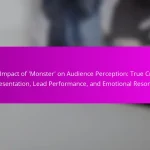The Night Stalker is a reference to Richard Ramirez, an American serial killer and rapist who terrorized California in the mid-1980s. Convicted of 13 murders and numerous other violent crimes, Ramirez’s actions were marked by extreme brutality and a chaotic, disorganized approach. His psychological profile reveals traits of sadism and sociopathy, influenced by a troubled childhood and substance abuse. The article examines the victimology associated with Ramirez, highlighting his targeting of vulnerable individuals and the widespread panic his crimes instigated. Additionally, it discusses the significant challenges faced by law enforcement in apprehending him, including a lack of physical evidence and the complexities of coordinating across jurisdictions.

What is the Night Stalker?
The Night Stalker refers to Richard Ramirez, an American serial killer and rapist. He operated in California during the mid-1980s. Ramirez was convicted of 13 murders, 5 attempted murders, and 11 [censured] assaults. His crimes were characterized by extreme violence and a lack of clear motive. The Night Stalker gained notoriety for his method of entry into homes, often through unlocked doors and windows. He was apprehended in 1985 after being identified by witnesses. His trial began in 1988 and lasted for several years. Ramirez was sentenced to death in 1989 but died in prison in 2013.
How did the Night Stalker become infamous?
The Night Stalker, also known as Richard Ramirez, became infamous due to his series of brutal crimes in California during the mid-1980s. He committed at least 13 murders, 5 attempted murders, and numerous [censured] assaults. His methods included home invasion, where he attacked victims in their sleep. The media extensively covered his crimes, amplifying public fear and fascination. Ramirez’s trial attracted significant attention, with graphic details of his actions being reported. His appearance, marked by a pentagram tattoo, and his courtroom behavior further fueled his notoriety. The combination of his heinous acts, media sensationalism, and psychological profile solidified his status as a notorious serial killer.
What were the key events that defined the Night Stalker’s criminal activities?
The key events that defined the Night Stalker’s criminal activities include a series of brutal home invasions and murders in California. Richard Ramirez, known as the Night Stalker, began his crime spree in 1984. He targeted both men and women, often breaking into homes at night. His first confirmed murder occurred on June 28, 1984, when he killed 79-year-old Jennie Vincow. Over the next year, he committed at least 13 murders and numerous [censured] assaults. His methods included using a variety of weapons, such as a gun and a knife. Ramirez was also known for his satanic rituals, which he sometimes performed at crime scenes. His capture in 1985 followed a public manhunt and identification by witnesses. The trial began in 1988, leading to his conviction and death sentence in 1989.
What impact did the Night Stalker have on public perception of crime?
The Night Stalker significantly heightened public fear of crime. His crime spree in the mid-1980s involved brutal home invasions and murders across California. This led to widespread media coverage, which amplified anxiety among residents. The public perception shifted to viewing crime as an imminent threat, especially in urban areas. Reports indicated that many people began to take extra precautions for their safety. The case also influenced discussions about mental health and criminal behavior. Law enforcement faced increased pressure to solve the case quickly due to public outcry. Overall, the Night Stalker’s actions created a lasting impact on societal views regarding safety and crime.
What are the defining characteristics of the Night Stalker?
The Night Stalker, also known as Richard Ramirez, is characterized by his modus operandi of breaking into homes at night. He targeted both men and women, often using a combination of [censured] assault and murder. Ramirez displayed a high level of brutality in his attacks, which included using weapons such as guns and knives. His victims were chosen randomly, leading to widespread fear in the communities he targeted. He often left behind symbols, such as pentagrams, which indicated his interest in the occult. The Night Stalker was also known for his ability to evade law enforcement for an extended period. His capture in 1985 was facilitated by public tips after his image was broadcast in the media. These characteristics highlight the psychological profile of a serial killer driven by a desire for power and control.
What psychological traits are associated with the Night Stalker?
The Night Stalker, also known as Richard Ramirez, exhibited several psychological traits. He displayed extreme levels of narcissism and a lack of empathy. His behaviors suggested a thrill-seeking personality, often deriving pleasure from the suffering of his victims. Ramirez also demonstrated sadistic tendencies, as evidenced by the brutality of his crimes. He engaged in ritualistic behaviors, which indicated a need for power and control. Additionally, he had a history of substance abuse, which may have exacerbated his violent tendencies. His actions were characterized by impulsivity and a disregard for societal norms. These traits contributed to his ability to evade capture for an extended period.
How do these traits compare to other serial offenders?
The traits of the Night Stalker, Richard Ramirez, differ significantly from other serial offenders. Ramirez exhibited a high level of brutality, often employing a combination of [censured] assault and murder. Many serial offenders may focus on a specific victim type or method, but Ramirez’s randomness set him apart. He also displayed a lack of remorse, a trait common among serial offenders, but his particular sadistic tendencies were more pronounced. Research shows that the average serial offender often has a cooling-off period, whereas Ramirez committed crimes in rapid succession. His use of satanic symbols during the crimes also distinguishes him from typical offenders. This unique blend of characteristics contributes to his notoriety in criminal psychology.

What is the psychological profile of the Night Stalker?
The psychological profile of the Night Stalker, Richard Ramirez, indicates traits of a sadistic personality and sociopathy. He exhibited a lack of empathy and remorse for his crimes. Ramirez had a history of substance abuse, which likely exacerbated his violent tendencies. He was known to derive pleasure from the suffering of his victims. His criminal behavior included [censured] assault, burglary, and murder, showcasing a pattern of escalating violence. Ramirez’s actions were often impulsive and chaotic, reflecting a disorganized approach to his crimes. His childhood exposure to trauma and violence contributed to his psychological development. Additionally, he displayed a fascination with Satanism, which influenced his criminal activities. These factors collectively illustrate a complex and disturbed psychological profile.
What psychological theories explain the Night Stalker’s behavior?
The Night Stalker’s behavior can be explained through several psychological theories. One prominent theory is the psychopathology perspective, which suggests that he exhibited traits of antisocial personality disorder. This disorder is characterized by a lack of empathy, remorse, and impulsivity.
Another relevant theory is the social learning theory. This theory posits that behaviors are learned through observation and imitation. The Night Stalker may have been influenced by violent media or criminal role models.
Additionally, the thrill-seeking theory indicates that he derived pleasure from the act of killing. This aligns with the concept of sensation-seeking, where individuals engage in risky behaviors for excitement.
Lastly, the trauma theory suggests that early life experiences, such as abuse or neglect, shaped his violent tendencies. Research indicates that a history of trauma can lead to aggressive behavior in adulthood.
These theories collectively provide a framework for understanding the psychological factors that contributed to the Night Stalker’s criminal behavior.
How do childhood experiences influence the Night Stalker’s actions?
Childhood experiences significantly influenced the Night Stalker’s actions. Richard Ramirez, known as the Night Stalker, faced a traumatic upbringing. He was exposed to violence from a young age, including witnessing his father’s abusive behavior. This early exposure to brutality likely desensitized him to violence. Additionally, he experienced neglect and a lack of parental guidance. These factors contributed to his development of antisocial behaviors. His childhood experiences shaped his worldview and his later criminal actions. Research indicates that childhood trauma can lead to increased aggression and criminal behavior in adulthood.
What role does mental illness play in the Night Stalker’s profile?
Mental illness plays a significant role in the Night Stalker’s profile. Richard Ramirez exhibited signs of psychological disorders, including possible schizophrenia and delusional thinking. His actions suggest a lack of empathy and remorse, common traits in individuals with severe mental illness. Ramirez’s history of substance abuse further complicated his psychological state. Reports indicate he experienced hallucinations and paranoia, influencing his violent behavior. The interplay of these mental health issues contributed to his criminal patterns and modus operandi. Understanding his mental illness provides insight into his motivations and the challenges faced by law enforcement.
What patterns can be identified in the Night Stalker’s modus operandi?
The Night Stalker exhibited several identifiable patterns in his modus operandi. He primarily targeted victims at night, often breaking into their homes. His victims were typically women, but he also attacked men and children. He used a variety of weapons, including firearms and knives, to inflict harm. The attacker frequently employed a method of surprise, which contributed to the vulnerability of his victims. He often left behind symbolic items, such as shoes or personal belongings, at the crime scenes. The Night Stalker also displayed a level of premeditation, scouting neighborhoods before committing his crimes. His attacks were characterized by extreme violence, often involving [censured] assault. These patterns highlight the calculated nature of his criminal behavior.
How did the Night Stalker select his victims?
The Night Stalker selected his victims based on vulnerability and accessibility. He often targeted individuals who were alone, particularly in their homes. Many of his victims were elderly or female, which made them easier targets. He typically chose homes that were unlocked or had minimal security measures. This pattern allowed him to enter without detection. His modus operandi included breaking in at night, taking advantage of the darkness. The randomness of his selection also contributed to widespread fear. The combination of these factors made his attacks particularly shocking and difficult to predict.
What methods did the Night Stalker use to commit his crimes?
The Night Stalker, also known as Richard Ramirez, used various methods to commit his crimes. He primarily targeted victims in their homes, often during the night. Ramirez utilized a range of weapons, including firearms, knives, and blunt objects. He frequently gained entry through unlocked doors or windows. Once inside, he would overpower his victims, often using physical force.
Ramirez’s methods included [censured] assault, robbery, and murder. He displayed a pattern of escalating violence throughout his crime spree. His attacks were often characterized by a lack of apparent motive, leading to widespread fear. Law enforcement linked his crimes through ballistic evidence and witness testimonies. The combination of his tactics and the random nature of his attacks made him particularly notorious.

What are the victimology aspects related to the Night Stalker?
The victimology aspects related to the Night Stalker, Richard Ramirez, include his targeting of vulnerable individuals. Ramirez primarily attacked women, often in their homes, which heightened the sense of fear among residents in California during the 1980s. His victims ranged in age from young adults to the elderly, indicating a lack of specific demographic targeting. Many victims were sexually assaulted, which added a layer of psychological trauma beyond the physical harm. The randomness of his attacks created widespread panic, leading to heightened security measures in communities. Additionally, his use of a variety of weapons, including firearms and knives, contributed to the violent nature of his crimes. The aftermath of his crimes left lasting impacts on victims’ families and communities, highlighting the broader implications of his actions beyond immediate physical harm.
Who were the primary victims of the Night Stalker?
The primary victims of the Night Stalker were individuals targeted in their homes across California. Richard Ramirez, the Night Stalker, committed a series of brutal attacks between 1984 and 1985. His victims included men, women, and children, with ages ranging from 9 to 83 years old. Many were assaulted, murdered, or sexually assaulted. The attacks occurred in various locations, primarily in Los Angeles and the San Francisco Bay Area. The Night Stalker was known for his method of entering homes through unlocked doors and windows. His crime spree instilled fear in the community, leading to increased vigilance among residents. Ultimately, he was convicted of 13 murders and numerous other crimes.
What common characteristics did the victims share?
The victims of the Night Stalker shared several common characteristics. Most were vulnerable individuals, often living alone. Many were women aged between 30 and 60 years. The victims typically resided in urban areas of California. They often lived in homes that were easily accessible. A significant number of victims were of Hispanic descent. The attackers targeted those who were perceived as less likely to resist. These shared traits made them more appealing targets for the assailant. This pattern helped law enforcement identify the profile of potential victims.
How did the Night Stalker’s choice of victims reflect his psychological profile?
The Night Stalker’s choice of victims reflected his psychological profile through a pattern of targeting vulnerable individuals. He predominantly selected women, particularly those who were alone or in isolated settings. This choice indicates a need for control and domination over helpless victims. His attacks often involved elements of [censured] violence, showcasing a deep-seated aggression and [censured] sadism. The randomness of his victim selection also suggests impulsivity and a thrill-seeking behavior. Additionally, he targeted victims of various ages and backgrounds, which may reflect a broader psychological need to instill fear across a wide demographic. This pattern aligns with the profile of a serial offender seeking power and gratification through violence.
What were the long-term effects on the victims and their families?
Victims and their families experienced significant long-term psychological trauma. Many victims suffered from post-traumatic stress disorder (PTSD), anxiety, and depression for years after the events. Families faced ongoing fear and insecurity, impacting their daily lives and relationships. The emotional scars often led to strained familial connections and social isolation. Long-term effects also included financial burdens from medical treatments and therapy. Some families relocated to escape the memories associated with the crimes. Community trust was eroded, leading to a heightened sense of vulnerability among residents. Studies indicate that such trauma can persist for decades, affecting mental health and overall quality of life.
How did the community respond to the Night Stalker’s crimes?
The community responded with fear and vigilance to the Night Stalker’s crimes. Residents heightened their security measures. Many slept with lights on and doors locked. Community meetings were held to discuss safety strategies. Neighbors formed watch groups to monitor suspicious activities. The media amplified the sense of urgency through extensive coverage. Public fear led to increased calls to law enforcement. This collective anxiety illustrated the profound impact of the crimes on daily life.
What support systems were available for the victims’ families?
Support systems for the victims’ families included counseling services and support groups. These services aimed to provide emotional and psychological assistance. Families could access grief counseling to help process their loss. Support groups facilitated sharing experiences with others in similar situations. Additionally, law enforcement agencies offered resources for victim assistance. Victim advocacy programs provided legal support and guidance. Community organizations also played a role in offering assistance. These systems aimed to help families cope with the aftermath of the crimes.

What challenges did law enforcement face in capturing the Night Stalker?
Law enforcement faced multiple challenges in capturing the Night Stalker, also known as Richard Ramirez. One major challenge was the lack of physical evidence linking him to the crimes. Many of the attacks occurred in different jurisdictions, complicating coordination among various police departments. Additionally, the media frenzy created public pressure, often leading to misinformation. Witness descriptions were inconsistent, making it difficult to create a reliable profile. The Night Stalker also used varied methods, which hindered pattern recognition. His ability to blend into different neighborhoods made him harder to identify. Finally, the investigative resources were stretched thin due to the high volume of cases during that period. These factors collectively delayed his capture until 1985.
What investigative techniques were employed during the Night Stalker case?
The investigative techniques employed during the Night Stalker case included forensic analysis, witness interviews, and surveillance operations. Investigators utilized forensic evidence from the crime scenes to link the murders. This included fingerprint analysis and DNA testing. Witness interviews helped gather descriptions of the suspect. Law enforcement also deployed surveillance to monitor potential locations. Task forces were created to coordinate efforts among various agencies. The use of composite sketches aided in identifying the suspect. Public appeals for information were made to gather tips. These techniques collectively contributed to the eventual capture of Richard Ramirez.
How did forensic evidence play a role in the investigation?
Forensic evidence was crucial in the investigation of the Night Stalker case. It provided tangible links between the suspect and the crime scenes. DNA evidence collected from the victims helped establish a profile of the assailant. Additionally, fingerprints found at various locations matched those of Richard Ramirez. Ballistics analysis connected the firearms used in the crimes to the suspect. These pieces of evidence guided law enforcement in narrowing down their search. The forensic evidence ultimately contributed to the successful apprehension and conviction of Ramirez.
What challenges did law enforcement encounter with public fear and misinformation?
Law enforcement faced significant challenges due to public fear and misinformation during the Night Stalker case. Public fear escalated as the media sensationalized the crimes. This heightened anxiety led to community panic and distrust in law enforcement. Misinformation spread rapidly through social media and word of mouth. False reports and rumors complicated investigations and diverted resources. Law enforcement struggled to maintain public order amid the chaos. They also faced difficulty in communicating accurate information effectively. This situation hindered cooperation from the public, as fear often resulted in reluctance to engage with authorities.
What lessons were learned from the Night Stalker investigation?
The Night Stalker investigation revealed critical lessons about law enforcement coordination and public communication. Effective communication among agencies is essential for sharing information. The investigation highlighted the importance of utilizing forensic evidence to link crimes. It also showed the necessity of community engagement in providing tips and support. Victimology insights stressed the need for understanding victim profiles to prevent future attacks. Finally, the case underscored the significance of psychological profiling in identifying and capturing suspects. These lessons have shaped modern investigative practices and improved response strategies for serial crimes.
How have these lessons influenced current law enforcement practices?
Lessons from the Night Stalker case have significantly influenced current law enforcement practices. Enhanced profiling techniques are now employed to better understand serial offenders. Investigators utilize behavioral analysis to identify patterns in criminal behavior. Improved inter-agency communication has been established to share critical information swiftly. The integration of forensic science has become standard in solving cases. Training programs now emphasize psychological insights into criminal motives. Technology, such as DNA analysis, plays a crucial role in modern investigations. These practices aim to increase efficiency and effectiveness in law enforcement responses.
What improvements were made in community policing as a result of this case?
The case of the Night Stalker led to significant improvements in community policing. Law enforcement agencies enhanced their collaboration with community members. They implemented neighborhood watch programs to encourage citizen involvement. Police departments increased transparency in their operations to build trust. They also prioritized training on cultural sensitivity and communication skills. These changes aimed to foster stronger relationships between police and the communities they serve. The focus shifted towards proactive measures in crime prevention. Overall, these improvements strengthened community engagement and enhanced public safety efforts.
What can communities do to protect themselves from similar threats?
Communities can enhance their safety by implementing neighborhood watch programs. These programs encourage residents to be vigilant and report suspicious activities. Increased communication among community members fosters a sense of collective responsibility. Regular safety meetings can educate residents about potential threats and prevention strategies. Collaboration with local law enforcement can improve response times and resources. Utilizing technology, such as security cameras, can deter criminal activity. Establishing strong community ties promotes trust and cooperation. Research shows that proactive community engagement significantly reduces crime rates.
The Night Stalker refers to Richard Ramirez, an infamous American serial killer and rapist who operated in California during the mid-1980s. This article provides an in-depth examination of his psychological profile, victimology, and the challenges law enforcement faced during his capture. Key topics include the defining characteristics of Ramirez’s crimes, the impact on public perception of crime, and the long-term effects on victims and their families. Additionally, the article discusses investigative techniques, lessons learned from the case, and improvements in community policing practices to enhance safety against similar threats.


